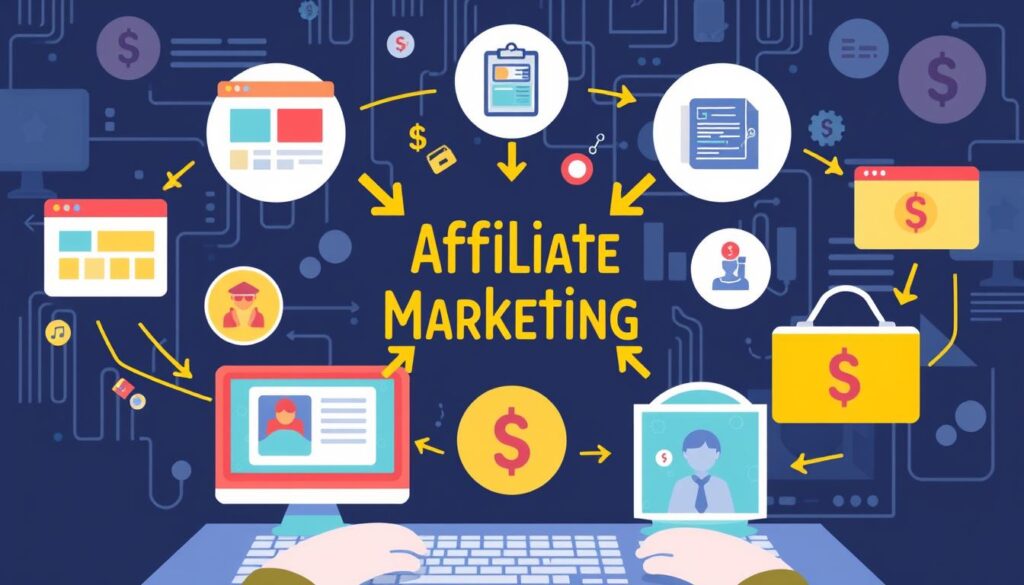
Affiliate marketing success doesn’t happen by chance—it’s built on a well-planned content strategy that attracts the right audience, builds trust, and converts readers into buyers. If you’re struggling to get consistent traffic and commissions, you need a clear content plan that aligns with your affiliate goals.
In this guide, I’ll walk you through the step-by-step process of creating a winning content strategy for affiliate marketing so you can drive traffic, increase conversions, and grow your passive income.
Step 1: Define Your Affiliate Marketing Goals
Before creating content, you need a clear goal. Ask yourself:
✔️ Do I want to build passive income or earn fast commissions?
✔️ Am I targeting high-ticket affiliate products or recurring revenue streams?
✔️ What’s my monetization plan—SEO, social media, paid ads, or email marketing?
Your goals will determine what type of content you create and which strategies to focus on.
Step 2: Choose a Profitable Niche
Your content strategy must align with a profitable niche that has:
✔️ High-demand products with good commission rates
✔️ A target audience that actively searches for solutions
✔️ Low to moderate competition for easier ranking opportunities
Some profitable niches include:
🔥 Health & Wellness (weight loss, supplements, fitness equipment)
🔥 Make Money Online (affiliate marketing, freelancing, passive income)
🔥 Technology & Software (SaaS tools, hosting, VPNs, AI tools)
🔥 Personal Finance (investing, budgeting, side hustles)
Picking the right niche ensures your content gets consistent traffic and higher conversions.
Step 3: Research Your Target Audience
To create high-converting content, you must understand:
📌 What problems your audience faces (e.g., “How to start affiliate marketing with no money?”)
📌 What type of content they consume (blog posts, videos, emails, social media)
📌 Where they hang out online (forums, YouTube, TikTok, Reddit, Facebook groups)
Use tools like Google Trends, AnswerThePublic, and Reddit to find out what your audience is searching for.
Step 4: Create a Keyword Strategy
A strong content strategy starts with keyword research. You need to find:
🔍 High-traffic keywords – Popular search terms that bring in steady organic traffic
🔍 Low-competition keywords – Easier to rank and attract targeted visitors
🔍 Buyer-intent keywords – Keywords that indicate people are ready to buy
Types of Keywords to Target:
- Informational Keywords: (“What is affiliate marketing?”) – Great for blog traffic
- Comparison Keywords: (“ClickBank vs Amazon Associates”) – Helps users decide
- Transactional Keywords: (“Best affiliate marketing course 2025”) – Leads to sales
Use tools like Ubersuggest, Ahrefs, and Google Keyword Planner to find the best keywords.
Step 5: Choose the Best Content Types
Affiliate marketing works best with a mix of content types, including:
📌 How-To Guides & Tutorials – Helps beginners learn (e.g., How to Start Affiliate Marketing Step-by-Step)
📌 Product Reviews – High-converting content (e.g., Is ClickFunnels Worth It? Honest Review)
📌 Comparison Posts – Helps buyers choose (e.g., SEMrush vs Ahrefs: Which is Better?)
📌 Listicles & Best-of Guides – Showcases top products (e.g., 10 Best Affiliate Programs for Beginners in 2025)
📌 Case Studies & Success Stories – Builds trust (e.g., How I Earned £5K/Month with Affiliate Marketing)
The more value-driven and engaging your content, the higher your chances of converting readers into buyers.
Step 6: Plan Your Content Calendar
A consistent content schedule keeps your traffic and engagement growing.
Content Publishing Plan Example:
📅 Week 1: Publish a how-to guide (How to Choose a Niche for Affiliate Marketing)
📅 Week 2: Publish a comparison post (ClickBank vs CJ Affiliate: Which Pays More?)
📅 Week 3: Publish a listicle (5 High-Paying Affiliate Programs You Need to Join)
📅 Week 4: Publish a review post (Is Bluehost the Best Hosting for Affiliate Marketing?)
💡 Pro Tip: Use a tool like Trello or Notion to organize and track your content plan.
Step 7: Optimize Your Content for SEO
To rank on Google and get free traffic, optimize your content by:
✔️ Using your target keyword in the title, URL, and headings
✔️ Writing engaging, long-form content (1,500+ words)
✔️ Adding internal links to other relevant blog posts
✔️ Using eye-catching images and videos
✔️ Writing a compelling meta description to increase clicks
SEO-friendly content will attract organic visitors for months or even years!
Step 8: Promote Your Content & Drive Traffic
Even the best content won’t rank without promotion. Use:
🔥 Social Media Marketing – Share on Facebook, Twitter, Pinterest, and TikTok
🔥 Email Marketing – Send new content to your email list
🔥 YouTube – Create video content that links back to your blog
🔥 Quora & Reddit – Answer questions and link to your blog posts
🔥 Guest Blogging – Publish on high-traffic sites for backlinks
The more exposure your content gets, the faster your affiliate commissions grow.
Step 9: Track & Improve Your Content Performance
📊 Use tools like Google Analytics & Google Search Console to monitor:
✔️ Traffic growth – Which posts bring in the most visitors?
✔️ Click-through rates (CTR) – Are your headlines attracting clicks?
✔️ Conversion rates – Which posts drive the most affiliate sales?
Double down on what’s working and tweak underperforming content to maximize results.
Final Thoughts: Build a Content Strategy That Drives Sales
Creating an effective content strategy is the key to long-term affiliate marketing success. By choosing the right niche, targeting profitable keywords, creating high-quality content, and promoting it strategically, you can build a sustainable income stream with affiliate marketing.
🔥 Want to fast-track your results? Join The Strategic Affiliate Course, where I’ll guide you step by step on how to create, promote, and scale your high-converting content strategy.
👉 Click here to enroll now and start building your passive income today! 🚀
Pingback:How To Create Compelling Content For Affiliate Marketing